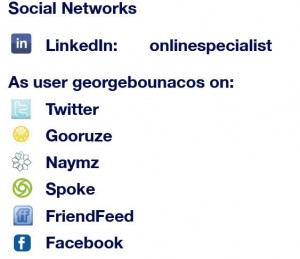
Social media is here and will shape the next conversation about marketing. For those of you who insist marketing and sales are separate, you remain correct. Sales is a subset of marketing. This conversation includes you too.
Remember Facebook, that college thing that all the cool kids did? Internet measurement firm Quantcast says that Facebook attracted more than 78 million visitors last month, and 23% of them were 35 years old or older. More surprising: 9% are 50 years old or older and that women far outnumber men.
The age demographic is more pronounced on Twitter, where 53% of the audience is over the age of 35. Twitter started as a geek haven so the older users aren’t that surprising. What may surprise you is that Quantcast estimates only 1% of Twitter visitors are teenagers.
The same data holds true for every social media site you can think of, even Digg, which is often viewed as the testosterone-fueled site of 20-something geeks. Quantcast directly measures Digg’s data, and while the gender split still exists (63% male), they are older guys. Well over half (59%) are over the age of 35, and one-third of that group is over 50 years old.
They’re smart too — 60% have college degrees.
No matter what small business you are leading or what type of marketing you are doing, you must be in the social media space right now. I said exactly that to a client this morning. He is leaving for vacation in days, but I’ve already told him to let his mind meander around social during that time because he is going to have to market there now.
Here’s the rub: if you don’t know your way around and you haven’t built social capital already, you’re going to get slaughtered in this space. Your marketing won’t be inefficient; it will be a money-loser. Even worse, your brand can take damage if you blunder into social media without knowing what you’re doing.

On the back of my business card is a list of how visitors on different social networks can reach me. In some cases, I was beta-testing these sites before they went public. In almost all, I was one of the first there.
Take Twitter for example. I wasn’t there first, but I was there in May of 2007. Not 2008, but 2007. Over that time, I think I earned enough credibility with those who follow me to go off on a rant or ask for someone to read or comment on something. Try that after you joined three days ago and blindly followed 1,000 people, and you will simply be ignored at best.
But you need to be there, marketing yourself and your organization, while also making sure that your personal brand is intact. The same people who today say that social media is a passing phase sagely nodded at other famous failed predictions (The worldwide market for computers is indeed larger than 5, and thank you Bill Gates, but using Vista we need more than 640K).
Twitter or Facebook or any other social network’s success in a decade is irrelevant. Amazon made its decade, so did eBay and many other companies. Perhaps some of these networks will too.
But today, right now, your clients, prospects, friends and relatives are there, and if you’re not there, you’re not in the game. More mainstream media hit the courts today when The Chicago Sun-Times filed for bankruptcy protection.
Would you rather advertise in a media that is in free-fall decline or one exploding with attention?
Carter Cole
it will be interesting to continue to see this market grow…
George Bounacos
I agree. To me the fascinating piece is convergence. We’ve moved from Exchange servers that guard email contact lists to email in the cloud, to iPads, email on my TV and smartphones.
We’ve all always said that the desktop as equipment would have a shelf life of maybe a generation and we’re nearing that point. 10 years ago I was desperately trying to get voice recognition to work at a startup. Today, it’s good enough for commercial use.
It’s an amazing time, and if you’re going to continue building tools you have a fun but tough challenge in becoming platform agnostic. Think about web access via a Blackberry or Wii. How in the world do we optimize that and optimize for web browsers too?